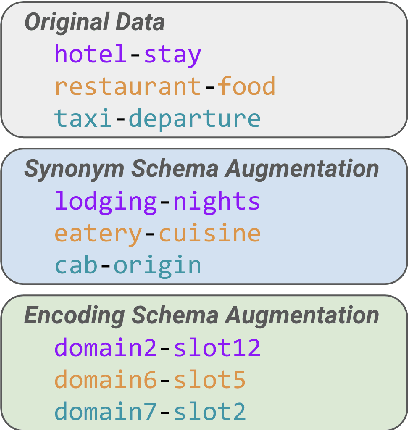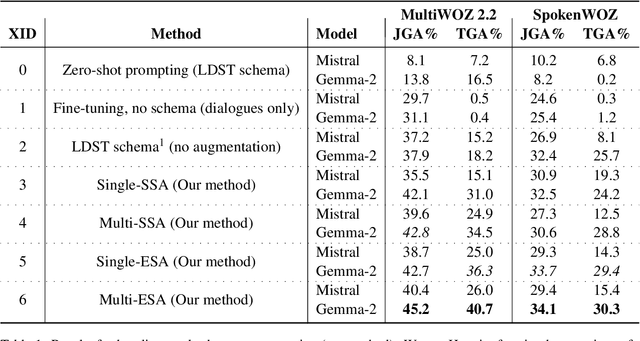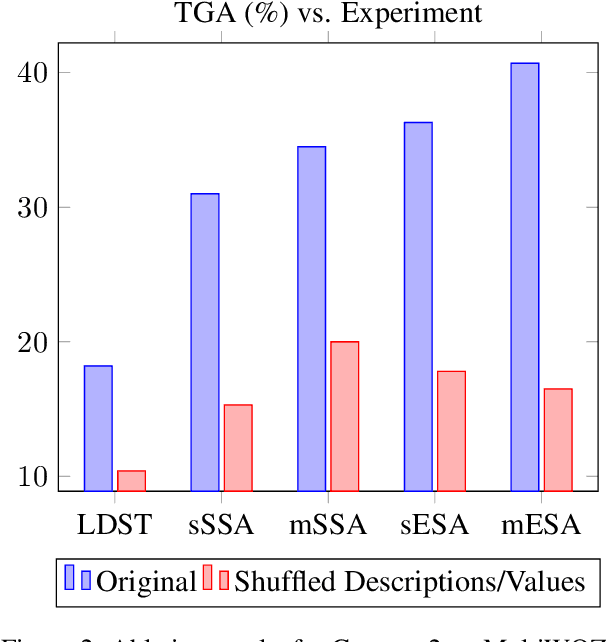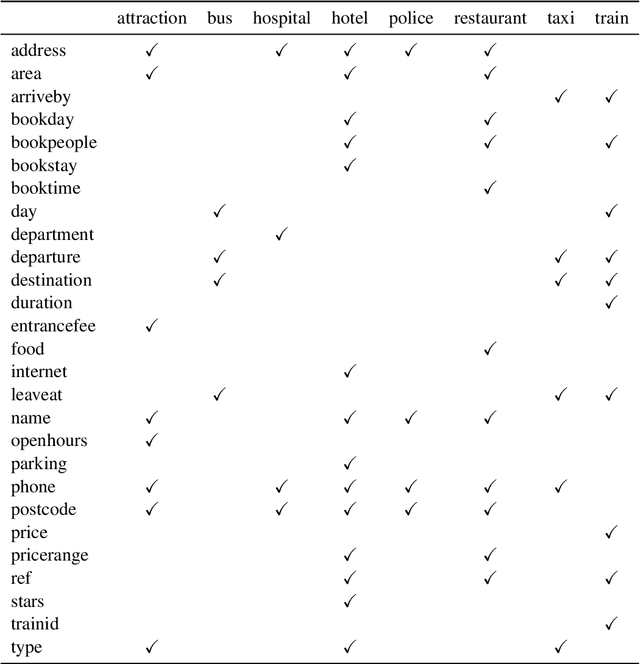Dialogue State Tracking
Dialogue state tracking consists of determining at each turn of a dialogue the full representation of what the user wants at that point in the dialogue, which contains a goal constraint, a set of requested slots, and the user's dialogue act.
Papers and Code
Boosting Universal LLM Reward Design through the Heuristic Reward Observation Space Evolution
Apr 10, 2025Large Language Models (LLMs) are emerging as promising tools for automated reinforcement learning (RL) reward design, owing to their robust capabilities in commonsense reasoning and code generation. By engaging in dialogues with RL agents, LLMs construct a Reward Observation Space (ROS) by selecting relevant environment states and defining their internal operations. However, existing frameworks have not effectively leveraged historical exploration data or manual task descriptions to iteratively evolve this space. In this paper, we propose a novel heuristic framework that enhances LLM-driven reward design by evolving the ROS through a table-based exploration caching mechanism and a text-code reconciliation strategy. Our framework introduces a state execution table, which tracks the historical usage and success rates of environment states, overcoming the Markovian constraint typically found in LLM dialogues and facilitating more effective exploration. Furthermore, we reconcile user-provided task descriptions with expert-defined success criteria using structured prompts, ensuring alignment in reward design objectives. Comprehensive evaluations on benchmark RL tasks demonstrate the effectiveness and stability of the proposed framework. Code and video demos are available at jingjjjjjie.github.io/LLM2Reward.
If an LLM Were a Character, Would It Know Its Own Story? Evaluating Lifelong Learning in LLMs
Mar 30, 2025Large language models (LLMs) can carry out human-like dialogue, but unlike humans, they are stateless due to the superposition property. However, during multi-turn, multi-agent interactions, LLMs begin to exhibit consistent, character-like behaviors, hinting at a form of emergent lifelong learning. Despite this, existing benchmarks often fail to capture these dynamics, primarily focusing on static, open-ended evaluations. To address this gap, we introduce LIFESTATE-BENCH, a benchmark designed to assess lifelong learning in LLMs. It features two episodic datasets: Hamlet and a synthetic script collection, rich in narrative structure and character interactions. Our fact checking evaluation probes models' self-awareness, episodic memory retrieval, and relationship tracking, across both parametric and non-parametric approaches. Experiments on models like Llama3.1-8B, GPT-4-turbo, and DeepSeek R1, we demonstrate that nonparametric methods significantly outperform parametric ones in managing stateful learning. However, all models exhibit challenges with catastrophic forgetting as interactions extend, highlighting the need for further advancements in lifelong learning.
Interpretable and Robust Dialogue State Tracking via Natural Language Summarization with LLMs
Mar 11, 2025This paper introduces a novel approach to Dialogue State Tracking (DST) that leverages Large Language Models (LLMs) to generate natural language descriptions of dialogue states, moving beyond traditional slot-value representations. Conventional DST methods struggle with open-domain dialogues and noisy inputs. Motivated by the generative capabilities of LLMs, our Natural Language DST (NL-DST) framework trains an LLM to directly synthesize human-readable state descriptions. We demonstrate through extensive experiments on MultiWOZ 2.1 and Taskmaster-1 datasets that NL-DST significantly outperforms rule-based and discriminative BERT-based DST baselines, as well as generative slot-filling GPT-2 DST models, in both Joint Goal Accuracy and Slot Accuracy. Ablation studies and human evaluations further validate the effectiveness of natural language state generation, highlighting its robustness to noise and enhanced interpretability. Our findings suggest that NL-DST offers a more flexible, accurate, and human-understandable approach to dialogue state tracking, paving the way for more robust and adaptable task-oriented dialogue systems.
Learning LLM Preference over Intra-Dialogue Pairs: A Framework for Utterance-level Understandings
Mar 07, 2025Large language models (LLMs) have demonstrated remarkable capabilities in handling complex dialogue tasks without requiring use case-specific fine-tuning. However, analyzing live dialogues in real-time necessitates low-latency processing systems, making it impractical to deploy models with billions of parameters due to latency constraints. As a result, practitioners often prefer smaller models with millions of parameters, trained on high-quality, human-annotated datasets. Yet, curating such datasets is both time-consuming and costly. Consequently, there is a growing need to combine the scalability of LLM-generated labels with the precision of human annotations, enabling fine-tuned smaller models to achieve both higher speed and accuracy comparable to larger models. In this paper, we introduce a simple yet effective framework to address this challenge. Our approach is specifically designed for per-utterance classification problems, which encompass tasks such as intent detection, dialogue state tracking, and more. To mitigate the impact of labeling errors from LLMs -- the primary source of inaccuracies in student models -- we propose a noise-reduced preference learning loss. Experimental results demonstrate that our method significantly improves accuracy across utterance-level dialogue tasks, including sentiment detection (over $2\%$), dialogue act classification (over $1.5\%$), etc.
Enhancing LLM Reliability via Explicit Knowledge Boundary Modeling
Mar 04, 2025Large language models (LLMs) frequently hallucinate due to misaligned self-awareness, generating erroneous outputs when addressing queries beyond their knowledge boundaries. While existing approaches mitigate hallucinations via uncertainty estimation or query rejection, they suffer from computational inefficiency or sacrificed helpfulness. To address these issues, we propose the Explicit Knowledge Boundary Modeling (EKBM) framework, integrating fast and slow reasoning systems to harmonize reliability and usability. The framework first employs a fast-thinking model to generate confidence-labeled responses, enabling immediate use of high-confidence outputs. For uncertain predictions, a slow refinement model conducts targeted reasoning to improve accuracy. To align model behavior with our proposed object, we propose a hybrid training pipeline, enhancing self-awareness without degrading task performance. Evaluations on dialogue state tracking tasks demonstrate that EKBM achieves superior model reliability over uncertainty-based baselines. Further analysis reveals that refinement substantially boosts accuracy while maintaining low computational overhead. Our work establishes a scalable paradigm for advancing LLM reliability and balancing accuracy and practical utility in error-sensitive applications.
PersuasiveToM: A Benchmark for Evaluating Machine Theory of Mind in Persuasive Dialogues
Feb 28, 2025The ability to understand and predict the mental states of oneself and others, known as the Theory of Mind (ToM), is crucial for effective social interactions. Recent research has emerged to evaluate whether Large Language Models (LLMs) exhibit a form of ToM. Although recent studies have evaluated ToM in LLMs, existing benchmarks focus predominantly on physical perception with principles guided by the Sally-Anne test in synthetic stories and conversations, failing to capture the complex psychological activities of mental states in real-life social interactions. To mitigate this gap, we propose PersuasiveToM, a benchmark designed to evaluate the ToM abilities of LLMs in persuasive dialogues. Our framework introduces two categories of questions: (1) ToM Reasoning, assessing the capacity of LLMs to track evolving mental states (e.g., desire shifts in persuadees), and (2) ToM Application, evaluating whether LLMs can take advantage of inferred mental states to select effective persuasion strategies (e.g., emphasize rarity) and evaluate the effectiveness of persuasion strategies. Experiments across eight state-of-the-art LLMs reveal that while models excel on multiple questions, they struggle to answer questions that need tracking the dynamics and shifts of mental states and understanding the mental states in the whole dialogue comprehensively. Our aim with PersuasiveToM is to allow an effective evaluation of the ToM reasoning ability of LLMs with more focus on complex psychological activities. Our code is available at https://github.com/Yu-Fangxu/PersuasiveToM.
Towards Preventing Overreliance on Task-Oriented Conversational AI Through Accountability Modeling
Jan 17, 2025Recent LLMs have enabled significant advancements for conversational agents. However, they are also well-known to hallucinate, i.e., they often produce responses that seem plausible but are not factually correct. On the other hand, users tend to over-rely on LLM-based AI agents; they accept the AI's suggestion even when it is wrong. Adding good friction, such as explanations or getting user confirmations, has been proposed as a mitigation in AI-supported decision-making systems. In this paper, we propose an accountability model for LLM-based task-oriented dialogue agents to address user overreliance via friction turns in cases of model uncertainty and errors associated with dialogue state tracking (DST). The accountability model is an augmented LLM with an additional accountability head, which functions as a binary classifier to predict the slots of the dialogue states. We perform our experiments with three backbone LLMs (Llama, Mistral, Gemma) on two established task-oriented datasets (MultiWOZ and Snips). Our empirical findings demonstrate that this approach not only enables reliable estimation of AI agent errors but also guides the LLM decoder in generating more accurate actions. We observe around 3% absolute improvement in joint goal accuracy by incorporating accountability heads in modern LLMs for the MultiWOZ dataset. We also show that this method enables the agent to self-correct its actions, further boosting its performance by 3%. Finally, we discuss the application of accountability modeling to prevent user overreliance by introducing friction.
Large Language Models as Theory of Mind Aware Generative Agents with Counterfactual Reflection
Jan 26, 2025



Recent studies have increasingly demonstrated that large language models (LLMs) possess significant theory of mind (ToM) capabilities, showing the potential for simulating the tracking of mental states in generative agents. In this study, we propose a novel paradigm called ToM-agent, designed to empower LLMs-based generative agents to simulate ToM in open-domain conversational interactions. ToM-agent disentangles the confidence from mental states, facilitating the emulation of an agent's perception of its counterpart's mental states, such as beliefs, desires, and intentions (BDIs). Using past conversation history and verbal reflections, ToM-Agent can dynamically adjust counterparts' inferred BDIs, along with related confidence levels. We further put forth a counterfactual intervention method that reflects on the gap between the predicted responses of counterparts and their real utterances, thereby enhancing the efficiency of reflection. Leveraging empathetic and persuasion dialogue datasets, we assess the advantages of implementing the ToM-agent with downstream tasks, as well as its performance in both the first-order and the \textit{second-order} ToM. Our findings indicate that the ToM-agent can grasp the underlying reasons for their counterpart's behaviors beyond mere semantic-emotional supporting or decision-making based on common sense, providing new insights for studying large-scale LLMs-based simulation of human social behaviors.
Intent-driven In-context Learning for Few-shot Dialogue State Tracking
Dec 04, 2024Dialogue state tracking (DST) plays an essential role in task-oriented dialogue systems. However, user's input may contain implicit information, posing significant challenges for DST tasks. Additionally, DST data includes complex information, which not only contains a large amount of noise unrelated to the current turn, but also makes constructing DST datasets expensive. To address these challenges, we introduce Intent-driven In-context Learning for Few-shot DST (IDIC-DST). By extracting user's intent, we propose an Intent-driven Dialogue Information Augmentation module to augment the dialogue information, which can track dialogue states more effectively. Moreover, we mask noisy information from DST data and rewrite user's input in the Intent-driven Examples Retrieval module, where we retrieve similar examples. We then utilize a pre-trained large language model to update the dialogue state using the augmented dialogue information and examples. Experimental results demonstrate that IDIC-DST achieves state-of-the-art performance in few-shot settings on MultiWOZ 2.1 and MultiWOZ 2.4 datasets.
Schema Augmentation for Zero-Shot Domain Adaptation in Dialogue State Tracking
Oct 31, 2024



Zero-shot domain adaptation for dialogue state tracking (DST) remains a challenging problem in task-oriented dialogue (TOD) systems, where models must generalize to target domains unseen at training time. Current large language model approaches for zero-shot domain adaptation rely on prompting to introduce knowledge pertaining to the target domains. However, their efficacy strongly depends on prompt engineering, as well as the zero-shot ability of the underlying language model. In this work, we devise a novel data augmentation approach, Schema Augmentation, that improves the zero-shot domain adaptation of language models through fine-tuning. Schema Augmentation is a simple but effective technique that enhances generalization by introducing variations of slot names within the schema provided in the prompt. Experiments on MultiWOZ and SpokenWOZ showed that the proposed approach resulted in a substantial improvement over the baseline, in some experiments achieving over a twofold accuracy gain over unseen domains while maintaining equal or superior performance over all domains.
 Add to Chrome
Add to Chrome Add to Firefox
Add to Firefox Add to Edge
Add to Edge